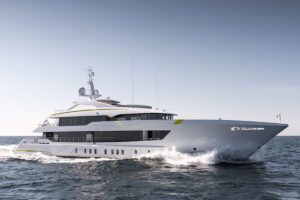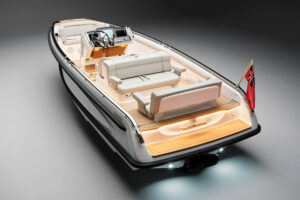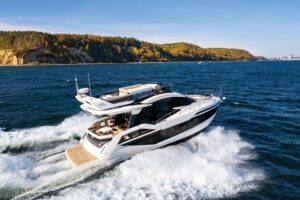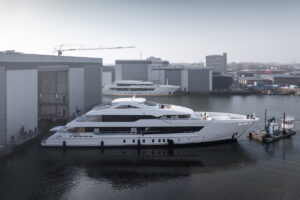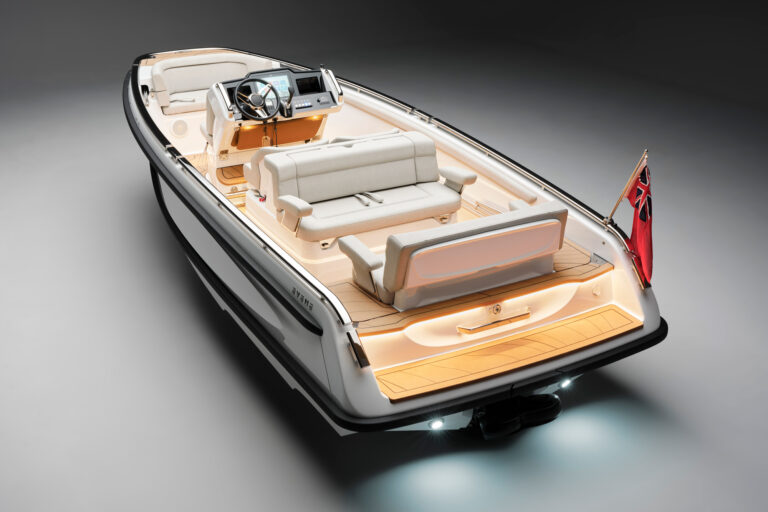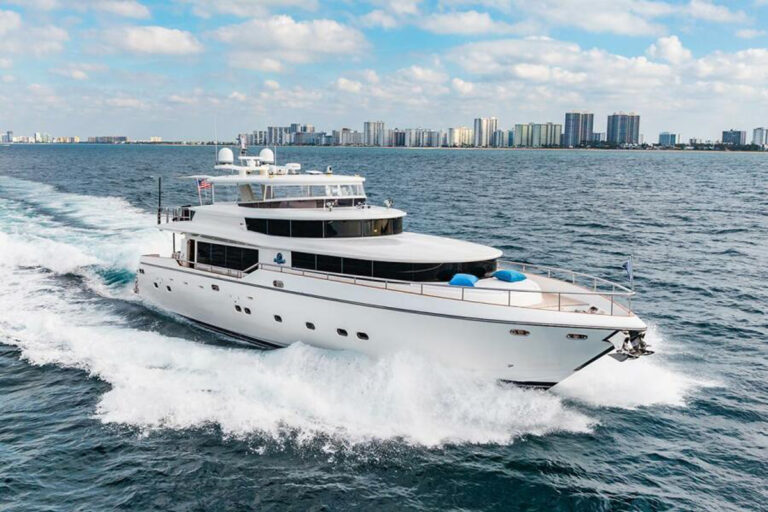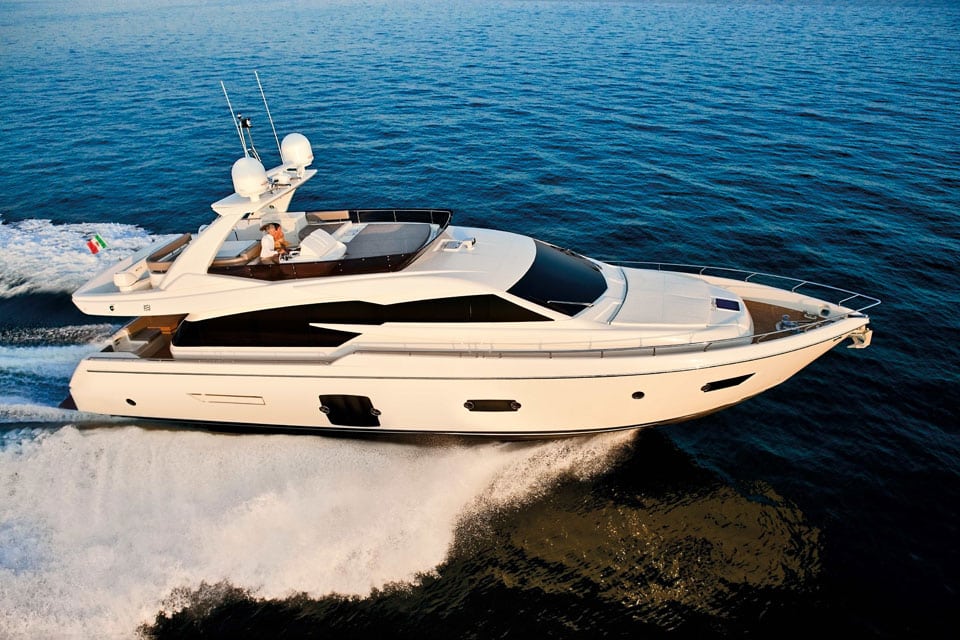
We know what we want: head-turning style, trip-shortening speed, spacious well-appointed accommodations, family-friendly features and reliability-enhancing, maintenance-reducing design and construction — but how many yachts have it all? Precious few, but the Ferretti 720 is one that delivers all that and more.
The favorable impressions began even before I boarded the 720 at Miami Beach’s Sunset Harbour Marina. The tide had ebbed, so I couldn’t easily access the swim platform from the fixed dock, at least not with the reality of 60-something knees punished by a lifetime aboard boats. No problem, as there’s a side gate in the bulwark that swings inward to provide an easy step onto the wide side deck. It sounds like no big deal until you realize that many yachts of this size have no gate at all, or one that swings outboard because the side deck isn’t wide enough to hinge it inboard. Outboard swinging gates are better than none, but I find they’re too often blocked by a piling or spring line.
Once aboard, I immediately noticed another nice feature. There’s an unobtrusive recess in the house side at the deck level, making the side deck — already comfortably wide — even more walkable by providing a few extra inches of toe space. Like the bulwark gate, it was just another of the many convenience and safety features I would find that were designed with the human body and the realities of the sea in mind (see “Design for Manufacturing” in the May 2012 issue of Yachting).
Click here to see a full photo gallery of the Ferretti 720.
I can’t cover them all, but one of note is the comfortable stairway from the main deck to the flying bridge, topped by a clear-glazed weather-tight hatch and surrounded by a stainless-steel railing that provides a convenient hand-grab and prevents anyone from falling. Again, it doesn’t seem like much unless you’ve stepped backward or lost your balance at sea, only to face an unguarded opening waiting to swallow you.
Once on the flying bridge, I happily noted another little feature, the too-frequent absence of which is a pet peeve of mine: The Gaggenau grill was fitted with a safety interlock to shut off the grill when the lid is closed. So what, you say? Well, I’ve seen the aftermath of fires caused by such installations without the interlock, and it’s not pretty. Fiberglass, after all, is mostly solidified petroleum.
It was Chamber of Commerce winter weather in Miami Beach the day of our sea trial — sunny, 75 degrees with a 10-knot breeze — but there was a bit of sea running as we headed from Government Cut past the Coast Guard station, into the Atlantic and toward the fringes of the Gulf Stream beyond. We were pretty heavy on fuel and water, so we topped out at 32.6 knots, about a knot shy of Ferretti’s published half-load speed of 33.5 knots. The builder, unlike many others, publishes data on speed vs. weight in its specifications, predicting 1 knot of speed loss for every extra 3,300 pounds of weight aboard the 720.
I love the opportunity to test a boat in real-world conditions, so the two- to three-footers, with an occasional four-footer thrown in just to keep us on our toes, were perfect for exploring the capabilities of the 720. She performed as expected and on a par with similar well-designed yachts. She rides on a traditional warped plane hull that terminates in a 12-degree deadrise at the stern. It is more suitable than a deep-V for a cruising boat like the 720, providing a good blend of seakeeping and load-carrying ability. Such hulls, however, can be a bit more sensitive to the larger waves, so when we took a couple of shots at top speed, it was neither unexpected nor a reflection on Ferretti, but simply a reality of physics. What did reflect well on Ferretti, however, was the fact that the boat didn’t display a hint of noise, vibration or internal movement from the impact. It just kept on going about its business. Pulling back the throttles to a cruise of just over 28 knots at 2,100 rpm provided an easier ride, as well as fuel savings of more than 24 percent, something that may figure importantly into this summer’s cruising plans if the fuel-price pundits are right.
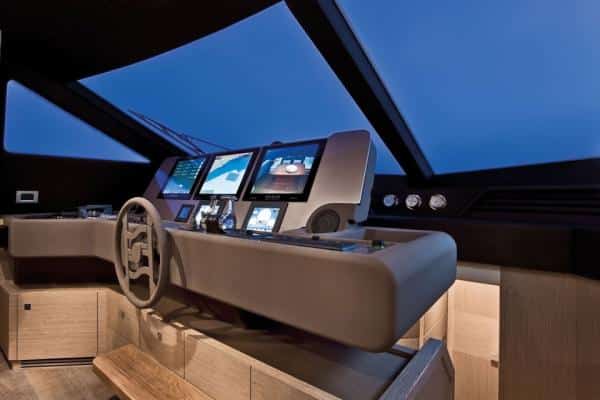
Back at Sunset Harbour, after running our speed trials in the sheltered and less-traveled waters south of Dodge Island, I took some time to give the 720 a good look, inside and out, and came away impressed with what I saw. The elements of good design that I spotted as I boarded continued throughout, and the machinery and equipment were first-class as well. Cummins Onan 23 kW gensets sit abaft the two MTU 10V diesels, with a Mitsubishi 4000 anti-rolling gyro under the Seafari watermaker to starboard and the main battery bank to port. There’s plenty of access room for routine maintenance, but if the yacht needs major work or equipment removed, a large hatch in the afterdeck can be lifted. Rounding out the engine-room equipment list are a Mastervolt charger and inverter, Racor duplex filters and a Fireboy fixed fire-extinguishing system activated by easy-to-reach controls in the starboard wing of the deckhouse aft; a docking station is housed opposite in the port wing. All controls, valves and switches, by the way, are clearly tagged in both Italian and English.
A gate and two steps lead down to the swim platform, mounted atop the extended hull and topping a huge utility lazarette, accessible via a gasketed power-lift hatch. The Cablemaster shore-power cable bin and drive are located here, as are the two independent ZF rudder actuators (there is no tie bar between the two). This electronically controlled system allows the steering to be programmed in a number of ways. Ferretti, for example, uses it to provide differential steering, with the inboard rudder turning more than the outboard one in a turn to better track the water flow without unnecessary drag. The steering also stays where you set it at engine speeds up to 1,800 rpm, but self-centers upon releasing the wheel above that point as a safety feature.
The Lofrans capstans, double bitts and roller fairleads at the stern are mounted thigh-high for stoop-free docking. Docking is further eased by full-length side decks, guarded by bulwarks topped with sturdy stainless-steel rails that incorporate spring-line cleats. Forward, Lofrans chain windlasses, mounted on an easy-to-clean recess in the teak deck, are complemented by substantial bitts, chocks and fairleads. The afterdeck has a table with chairs and settee, while the foredeck has a sun pad flanked by safety rails.
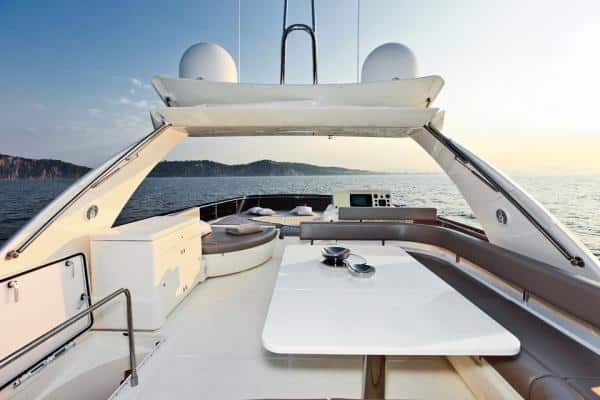
Topside, the flying bridge also has a sun pad, this one forward of the amidships helm. Abaft the helm is a large U-shape dining area to starboard, with a triple-section table for easier access to the middle seats. A snack bar, with sink, stowage, a small Isotherm refrigerator and the Gaggenau grill mentioned earlier, lies to port. The Bimini top folds into the radar arch when not deployed. Aft, a Besenzoni davit stands ready to handle the tender.
Accommodations below include four staterooms with modern decor and en suite heads; the one in the starboard twin-berth cabin shares duty as a day-head accessible from the passageway, while the port twin cabin is private. Forward is a queen-berth stateroom with two lockers, and aft is a king-berth master suite. All have large twin portlights with windows between, but the ones in the master are stunning, providing an unparalleled view of the sea. The doors in the master head can be fully opened, making the head, with its rainfall shower, a part of the cabin and allowing views to both sides. When the head’s in use, the doors provide complete privacy, and the window above the lavatory counter can be covered by a full-length sliding mirror, blinds or a blackout panel. Crew quarters for three, sharing a single head, are located abaft the engine room, with a separate entrance stair from the afterdeck.
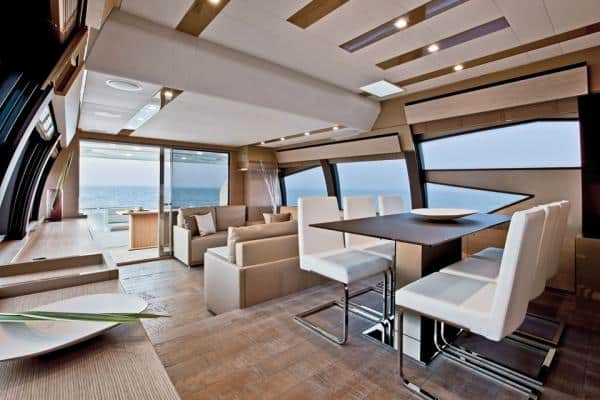
Blinds are also used in the main salon and dining room on the main deck, sliding on curved tracks to provide complete privacy or respite from the sun. Although there is no division bulkhead, a step in both the deck and the overhead serve to define the two areas. Forward are the galley and pilothouse, which can be closed off with an obscured glass door for the passageway and a pocket door for the galley. There’s also an electric pantograph door from the pilothouse to the port side deck and a chart flat to starboard. The galley has a GE Profile side-by-side refrigerator/freezer with in-the-door ice dispenser, a Bosch four-burner ceramic range, a GE Monogram oven and a deep single-bowl sink. Overhead, a clear-glazed hatch opens for light and fresh air.
The Ferretti 720 is the perfect yacht for a family interested in the cruising possibilities afforded by a fast, yet dependable, boat with flexible accommodations. It can be operated with or without crew, suitable for weekend trips and longer adventures. It has lots of room inside and out, in sun or shade. Top-notch finish and outfitting round out an attractive package that deserves your consideration.
Ferretti Yachts, 954-462-5527.
Click here to see more photos of the Ferretti 720.
To see more yachts from Ferretti, click here.

